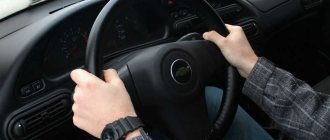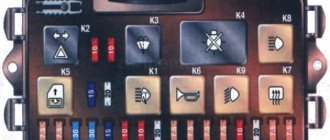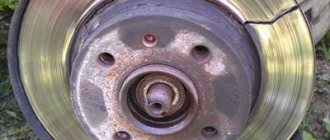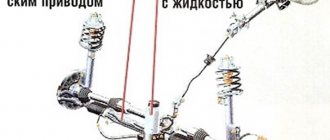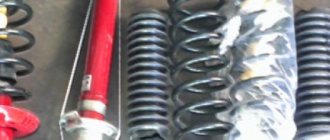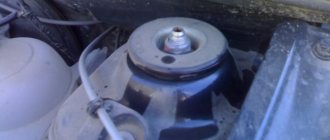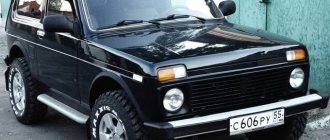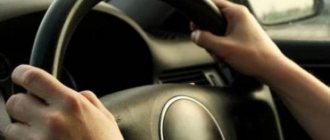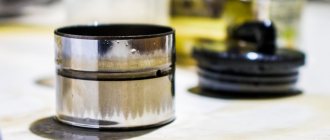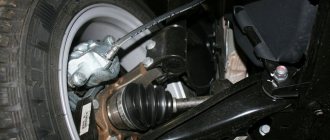15.02.2021
| (Votes: 1, Rating: 5) |
Issues discussed in the material:
- Diagnostic nuances when a knocking sound occurs when turning the steering wheel
- 7 most common causes of knocking noise when turning the steering wheel
- Other extraneous sounds when turning the steering wheel
- Why a knocking sound may occur when turning the steering wheel: stories of car owners
A knocking sound when turning the steering wheel may indicate a malfunction of one or another system in the car. And if the presence of some problems does not require immediate intervention, others can lead to the most dire consequences, even leading to an accident on the road.
There is only one conclusion here: having heard such an alarm bell, you need to immediately carry out a diagnosis. Only by absolutely determining exactly what is the reason for the knocking noise when turning the steering wheel can you make a decision: time is running out, or you need to immediately go to the service station.
If you hear a noticeable knocking noise when you move the steering wheel left to right: diagnosis
Probable Causes
If an audible knocking sound in the front suspension when turning the steering wheel indicates wear in its constituent parts, then an extraneous clicking sound when the steering wheel rocks requires inspection of other structural elements. As a rule, the problem lies in the vehicle control system.
Statistics show that there is something to knock in the “steering wheel”. Any pairing may come under suspicion:
- Gap in the fit between the steering tip and the strut.
- Excessive play in the steering rack.
- There is a problem with the steering shaft driveshaft.
- Free movement of the steering wheel on the shaft.
- Gap in steering rod joints.
These parts are present in the design of any car. Knowing the location of all the landings, it remains to identify the defective pair.
For your information. Some old foreign cars have a folding steering column assembly, which breaks under the influence of a critical load that occurs during an accident. He can knock too.
How to identify knocking: expert methods
The classic approach to identifying a faulty unit will be explained in any garage. Its essence is trivial: just ask the assistant to shake the steering wheel and at this time put his hand on the mentioned connections.
Steering rack
However, in some situations this technology loses its relevance. In particular, it will not be possible to identify a defect in the mechanism using this method. To identify a problem in the gear-rack engagement, it is necessary to carry out the following experiment:
- If there is power steering (hydraulic booster): a knocking sound appears when the steering wheel is rotated on a car with the engine turned off, but when the engine is running, there is no knocking at the place.
- There is no power steering: drive along a road section with a changeable direction - when you swing the steering wheel left to right, a knock is heard, but when turning, the rack does not knock due to the small wear of the working surfaces of the gearing in the extreme positions.
For your information. It is not recommended to tighten a worn rack. One of the owners of Hyundai Solaris performed this procedure and after 10,000-12,000 km the steering wheel began to bite. An autopsy showed that the mechanism was beyond repair.
Emergency system
It is also possible to determine experimentally whether the steering column folding assembly is the cause of the knocking. It is enough to swing the “steering wheel” to the sides, while simultaneously pressing it to the bottom. The sound disappeared - the problem is in the emergency system.
Knock in the steering wheel on uneven surfaces when driving straight ahead
In cases where knocking is heard on the steering wheel when driving over uneven surfaces, this may indicate wear on the bearings of the steering column shaft located in the cabin. This malfunction causes radial play of the shaft, accompanied by knocking. Axial play of the shaft is also possible due to wear of the locking or sealing rings. In some cases, manufacturers provide the supply of spare parts for inexpensive repair of the dispenser. During the overhaul, related parts, fastening and sealing elements are also replaced, which may still be in working order, but may soon fail and require repeated repair of the unit. On a number of models where disassembly and restoration are not provided, the steering column is replaced as an assembly.
Although knocking noises can clearly appear only when turning, not in all cases this is due to wear of the steering elements. If you hear a knock when turning the steering wheel, you should also carefully check the entire front suspension of the car, the tightness of the protection fasteners, subframe bolts and other underbody elements. Only a detailed comprehensive inspection will help identify the source of the problem, which is not always possible to do just by the nature of the knock.
What causes a knocking sound in the front suspension of a car when turning the steering wheel while driving?
The chassis and steering mechanism are tightly coupled and perform a single function. One rack command is not enough to turn the wheels in one direction. The racks, which are connected by tips and rods to the rack and pinion assembly, must not only absorb shock, but also rotate around their own axis. This became possible with the introduction of movable mounts.
What's causing the knocking?
When there is a knocking sound when turning the steering wheel while driving, but no extraneous sounds are observed in place, we can firmly state that there are problems with the suspension. Its design includes a sufficient number of connections that use bearings. Any support gradually fails, as evidenced by increased play.
- Strut support bearing.
- Spherical bearing.
- Wheel bearing.
How to identify tapping
You can calculate the knock in the front suspension of a car when turning the steering wheel experimentally. The work is carried out both on site and while moving - it all depends on the location of the defective area:
- The support bearing is checked by rocking the body to the sides: the hand lying on the “support” holder should not feel any play. The second diagnostic method: grab the front wheel spring and ask an assistant to rock the steering wheel to the sides - there should be no knocking.
- A metallic clatter will be heard in the worn out “ball” when bent with a pry bar.
- The hub support makes a dull knock when turning the steering wheel at small angles at a speed of 50-60 km/h.
For information
Often tapping occurs due to worn silent blocks. There are cases when the occurrence of a metallic sound is associated with the loosening of the nut securing the CV joints to the hubs. The hinge itself cannot knock - it is only capable of making a knock. A wheel spun with a small torque also interferes with acoustic comfort.
Inexperienced owners may confuse the symptoms of a steering malfunction with vibrations in the steering wheel when the car is braking. However, there the nature of the problem is completely different. Strong shocks in the steering wheel can be caused by poor-quality tires or imbalance in the wheel.
Lada Kalina (2019). Knocking and clicking noises when turning the car
| Lack of lubrication in the joint | Inspect the case. Remove the drive and check the hinge. Apply sufficient new lubricant to the joint and replace the damaged joint cover. If there is play, replace the hinge or drive assembly |
| The intermediate bearing is severely worn | Remove the intermediate support bracket and check the play in the bearing. If necessary, replace the intermediate bearing |
Steering rod silent blocks can also cause clicking noises.
. Wear of silent blocks and delamination of rubber can even produce clicks when turning the steering wheel in place and while driving. If this is the cause of the knocking, then the silent blocks must be replaced.
If the steering wheel clicks when turning
- check the tie rod ends and tie rods
When the rack bushings wear out, a knocking noise in the steering wheel may also occur. There is a small gap between the rack and gear. Sometimes it is possible to eliminate the gap using an adjusting bolt. If this does not help, then the worn bushings need to be replaced. The clicks may come from the steering column driveshaft. If damaged, it may make strange sounds. It just needs to be replaced. Clicks in the suspension when turning the steering wheel may indicate a breakdown of the outer CV joint. Then they will only appear when turning. If clicks occur when going uphill, then the inner CV joint is faulty. It is also easy to determine this breakdown: you need to drive the car onto an overpass and check the boots. If they do not fit well, the clamps are torn or have come off, then dirt has gotten inside the CV joint, and therefore it has failed. You should not delay the replacement, since over time the CV joint may completely turn out, then the car will need to be delivered to the repair site by tow truck or tow truck.
The cause of clicking noises when turning may be a faulty CV joint.
If clicks when turning are heard along with the characteristic hum of the wheels, then the problem lies in the wheel bearing. One of the most dangerous malfunctions, it is better to immediately replace the bearings, and if the driver is forced to drive such a car, then the speed should not exceed 80 km/h.
COMMON CAUSES OF KNOCKING RELATED TO THE STEERING GEAR
Now let's look at typical problems and how to fix them. The first thing you need to do is check the pressure in the wheels, because the difference in tire inflation may be the cause of the knocking. Then check the fastening of the plastic protective fender liners. It is quite possible that the screws that secure them to the body have broken out, causing the fender liner to come off and cling to the wheel, making a knocking sound when turning.
In general, such a malfunction is very easy to fix; all you need to do is secure the torn fender liner with new screws. The most dangerous from a safety point of view is the appearance of a knock in the steering mechanism itself. To check the condition of the mechanism, you will need to drive the car onto an overpass. The first thing you need to check is the steering ends. Damage to the tip boot leads to sand getting inside it, which intensively wears out the surfaces of this element, causing play to appear in the tip, which is the source of knocking.
You can check the condition of the ends by loosening the tie rod with a pry bar. Strong play and knocking will indicate wear on the tip and the need to replace it. Steering ends for domestic cars are relatively inexpensive, and you can purchase them at almost any auto store. Replacing them is also easy. It is recommended to replace both tips at once. The complexity of performing this work comes down to the need to use a special puller.
After replacing the tips, you will still have to contact a service station to set the wheel alignment angles. A knock may also appear in the steering rod silent blocks. They are located in the place where these rods are attached to the steering rack.
Delamination of the rubber of these silent blocks can also lead to knocking, although it will appear not only when turning, but constantly while driving. This steering mechanism malfunction, although very rare, is still possible. It can be eliminated by removing the steering rods and pressing in new silent blocks. A knock may also appear in the steering mechanism itself. It usually forms after the rack guide bushings wear out, causing a gap to appear between the rack and gear.
In some cases, everything can be eliminated by removing the gap with the mechanism's adjusting bolt. If this is no longer possible, you will need to remove the mechanism from the car, disassemble it and replace the worn guide bushings. A knock may even appear in the steering column universal joint.
If for some reason it is damaged, it is quite possible that it is the cause of the appearance of third-party sounds. This problem is “treated” by replacing the cardan. You should also check the fastening of the mechanism body to the car body. Loose clamps may cause noise. This can all be eliminated by tightening the fastening nuts. Return to content
DRIVE AND SUSPENSION REASONS
Now let's move on to other elements of the car in which knocking may occur when turning the steering wheel. There are not many of them, but malfunctions with them can lead to expensive repairs. If you hear a knocking sound with a crunching effect when the wheel is turned completely, this often indicates severe wear of the constant velocity joint (CV joint) used in the wheel drive mechanism. The CV joint itself is a fairly reliable element if it is protected from dust and dirt getting inside. Read on the topic - replacing the inner CV joint boot of popular car models.
Therefore, it is quite easy to determine that this is the cause of the knocking when turning - you need to carefully inspect the protective boot. If it is damaged, we can say with complete confidence that the cause of the third-party crunch is the CV joint. Many car enthusiasts claim that it is possible to fully restore the performance of the CV joint by removing it, washing it and adding new lubricant. Some additionally add small shavings of soft plastic to the lubricant, for example, from a cork from a Champagne bottle. Be sure to replace the damaged boot. However, such measures can only delay the replacement of the hinge for a while and in the end it will still have to be replaced. And when to perform this operation - immediately upon detection of damage to the boot, or a little later - it is up to the car enthusiast to decide. In many modern domestic cars, the weak point is the shock absorber strut bearing. It can also cause knocking. This problem seems to be easily solved - it is enough to replace the support, but sometimes this is not very easy to do. After all, you will have to remove the entire rack from the car. Also, a broken strut spring may be knocking in the suspension. At the same time, it will no longer be able to fully perform its functions, which will lead to rapid failure of the shock absorber. Therefore, if noise appears, you should immediately inspect the spring. If it bursts, you will have to change it, and it is changed in pairs on both sides of the car. If you hear a knocking sound on your car when turning, but it is also accompanied by a hum, it is likely that all this is due to wear on the wheel bearing. It is quite easy to diagnose his condition. You need to jack up the wheel on the side where the knock is coming from and rock it, checking for axial play. If such play exists, the bearing needs to be replaced, which is impossible to do without the appropriate equipment and knowledge.
ATYPICAL CAUSES
Often sounds may not appear due to the failure of any element; non-standard reasons also occur. For example, one car enthusiast experienced a knocking noise after a pebble flew onto the subframe and got stuck there. When the steering wheel was turned, the elements shifted, but they ran over this pebble, and when the steering wheel moved back, they jumped off it, making a knocking noise. Removing this stone eliminated the problem. For the second car enthusiast, after repairing the suspension, the replaced front arm hit the subframe when turning, which was accompanied by a knocking sound. This problem was “cured” by raising the subframe with a pry bar. These are somewhat unusual reasons for the appearance of knocking, but they have happened to car owners, so they should not be discounted. In general, often the cause of extraneous sound when turning the steering wheel can be identified by carefully inspecting the front of the car, as well as checking the fastening of certain elements. Return to content
PREVENTION OF KNOCKING
All of the above problems can arise not only with domestic cars, but also with expensive foreign cars. And the difference between these cars comes down only to the time after which the malfunction appears. Naturally, a foreign car will pass more without a malfunction than the same Priora. But repairing a foreign car, if, for example, its CV joint has failed, will cost much more. In most cases, knocking noises are caused by inadequate road surfaces. Moving over bumps and holes leads to the fact that all fasteners begin to weaken, hence the appearance of backlash. To prevent knocking noises when turning the steering wheel, periodic inspection of all elements is required. Moreover, this will require very little, and you can do everything yourself. The car is placed on an inspection hole or overpass, after which, while under it, you should carefully inspect all the elements, check the tightness of all fasteners with wrenches, tighten the nuts and bolts if necessary, swing the levers with a pry bar, checking for play. If you do all this periodically, you can avoid the occurrence of knocking noises, or at least increase the life of the car before they occur. Also, when traveling, you need to adhere to the speed limit, and pass difficult sections at low speed in order to slightly reduce the load on the elements of the suspension steering mechanism. And if in front of you unexpectedly there are depressions in the road surface, then slow down the car (the car will seem to nose down), and immediately before the problem section of the road, release the brake pedal. The front of the car will rise, thereby unloading the front suspension, and the car will coast over uneven roads without much damage to the chassis.
content .. 8 9 10 11 ..
Quick Guide
The main reason for tapping is the formation of a gap in the joints. In the steering system, there may be knocking on the tips, ball joints of the rods, the rack, the “cardan” in the column, the steering wheel on the shaft, or the auto-folding system in case of an accident. The metallic sound is distinct and can be heard in place when rocking the steering wheel.
It is quite possible to mistake problems in the suspension for problems in the steering, since the initial stages of wear of bearings and supports only make themselves felt when cornering at speed. In the suspension part, the cause of the knock should be sought in the wheel bearings, ball joints and “supports”.
A knocking sound when turning the steering wheel indicates problems with the vehicle's steering system. The causes of knocking may be malfunctions of the constant velocity joint (CV joint), ball joint, wear of the steering tip and/or support bearing, stabilizer link and other malfunctions. In any case, when a knock is heard when turning the steering wheel, it is necessary to carry out diagnostics as quickly as possible, since malfunctions of the steering system not only worsen over time, but can also lead to emergency situations when the car is moving, even an accident.
Non-standard cases
It may not be the suspension or steering parts that are knocking. Shocks and body pecks lead to the movement of units. If they “sit” loosely and there is metal-to-metal contact, clinking cannot be avoided.
- Single dull knock when starting off. See rubber-metal engine or gearbox mounts, transmission driveshaft. For example, when starting, the motor may tilt and hit the spar.
- Rattling on small bumps and in turns. Listen to see if there is a knocking sound in the steering wheel when braking; if there is, the brake caliper guides are worn out.
- Intermittent impact sound, more common when turning at low speeds. Malfunction in the differential of a front-wheel drive vehicle.
Tighten the key bolts and nuts more often, refuel only at gas stations with high-quality gasoline, and remember: a worn CV joint does not knock, but crunches, and does this with the wheels turned out.
Causes of knocking noise when turning the steering wheel
There are a number of reasons why a knock is heard when turning the steering wheel. To more accurately determine the malfunction, it is necessary to determine three circumstances:
- Sound type. It can be single or repeated, voiceless or voiced (usually metallic), loud or quiet.
- The place from which the sound comes. For example, in the wheel, in the suspension, in the steering wheel.
- Circumstances of occurrence. In particular, when driving, when turning the steering wheel in place, when the steering wheel is turned all the way, when turning left or right.
Based on such data, you can focus on the source of the knocking sound.
| Place of knock | Causes of knocking |
| Knocking in the wheel | Partial failure of the angular velocity joint (the boot is torn, problems with the bearing), noise from tie rods/steering rods, steering rack when driving on rough roads, shock absorber struts (spring knocking), stabilizer struts |
| Rack knock | Damage to the rack shaft, increased play of the bushing and/or shaft bearings, on machines with electric power steering, mechanical damage to the engine shaft and/or worm drive, wear in the steering shaft driveshaft |
| Knocking in the steering wheel | Partial failure of the steering rack, rusting of the rack drive shaft, wear of the worm drive in the EUR and/or mechanical problems with the electric motor |
| Steering wheel position | Causes of knocking |
| When turning the steering wheel all the way (left/right) | When replacing the front control arm, it is possible that the lever hits the subframe when turning. Sometimes craftsmen simply do not fully tighten the fasteners, which cause them to creak when turning. |
| When turning the steering wheel while the car is stationary | Faulty steering rack, universal joint, loose fasteners, tie rods/ends |
| When turning the steering wheel while the car is moving | The same reasons as when the car is stationary, but problems with stabilizer struts and shock absorber struts are added here. |
Below is a list of reasons why knocking occurs when turning in the area of the wheel, suspension and steering wheel, according to the degree of their prevalence.
Identifying possible causes of knocking
Turning the steering wheel of front-wheel drive cars involves many joints, levers and rubber seals. A knocking sound in the steering wheel when turning may indicate wear of components or parts.
First of all, the assistant can turn the steering wheel, and you can listen to sounds under the car. Sometimes it is difficult to determine a breakdown by hearing, so you can touch various parts with your hand.
Wheel arch protection
One of the common causes of knocking is loosening of the wheel arch protection. In this case, it first turns under the action of the wheel, then returns to its original position, which gives rise to a characteristic “plastic” sound. Reliable fixation of the plastic protection takes a few minutes.
Hinges
Knocking when turning wheels can be generated by hinge joints: steering tips and rods, earrings and stabilizer rods. The noise occurs when a dirty or unlubricated joint jams. Sometimes it is enough to lubricate it, sometimes it is necessary to replace it.
A metallic crack that accompanies a full turn of the steering wheel may indicate a breakdown of the constant velocity joint, or in popular parlance, a “grenade”. A cracking sound when turning in both directions means that both “grenades” need to be replaced. Failure of CV joints is usually associated with a rupture of the rubber boot that protects the mechanism body. Even a small tear is enough to create the need to replace one of the most expensive components of the chassis. Therefore, it is better to check the anthers once a month for damage.
Constant-velocity joint
With the wheels turned completely to one side, the CV joint will most often creak (it may even give impacts to the steering wheel). When turning the car to the left, the right outer CV joint will crunch/knock, and when turning to the right, the left one will, accordingly. Inner CV joints usually creak when driving at high speed on uneven roads, so they have nothing to do with knocking when turning. So if you hear a knocking sound when turning or sharply accelerating your car, the outer joint most likely needs to be replaced. However, first you can remove it and inspect it - if there is no wear or it is small, then CV joint lubrication will help.
Tie rods and tie rods
Due to natural wear and tear, the lugs and rods may, over time, become loose and squeak and make knocking noises when turning the machine. To diagnose, you need to jack up the car on the side where the annoying sound is coming from and first remove the wheel. Next, you need to shake the rods and tips and check for any play in them. It often happens that the boot on the tip breaks, which means dirt and moisture gets inside. This causes a corresponding knock.
There are cases when, for example, when performing a wheel alignment operation, a car enthusiast or master forgets to tighten the fastening nut between the steering rod and the steering tip. Accordingly, when you turn the steering wheel, both in motion and at a standstill, a loud metallic knock will be heard. You can determine more precisely if you shake the front wheel left and right with your hands, it will dangle and make similar sounds.
Racks and rack fastenings, supports and other mechanisms - we check
If the rack is knocking, you can determine it more or less simply. At the moment of swinging, you need to attach the hammer handle, for example, to a stand and see if the knock is transmitted to the attached object. It is quite possible that the spring is knocking, which has become deformed and has sagged. It is also possible to get a knock when the rack mounts come loose. There are such problems in these nodes:
- the upper mount of the strut in the form of a support has broken, this can be determined by opening the trunk and placing a finger on the mount, and then rocking the car up and down;
- the lower mount has lost its elasticity, this is also easy to check using the same operation, but only in a hole under the car - put your hand on the mount;
- the strut itself has failed, you can determine this by eliminating all other options and problems with the suspension, then the shock absorber on your car will need to be replaced;
- Next, it’s also worth checking the spring, which can make different sounds, the coils can hit each other, there are a number of other problems that break the spring;
- For a full diagnosis, it is possible to remove the rack and then disassemble the parts with separate diagnostics, but this is carried out at a time when nothing else helps.
It often happens that everything is in order during diagnostics, but while driving the car makes a knocking noise. In this case, you will have to disassemble the rear suspension mechanism. We would like to immediately warn those motorists who want to do this themselves. This is not the best option, since you need to fully understand each rear suspension component in order to then install all the parts in the normal sequence. Otherwise, you cannot avoid problems.
Steering rack
Steering rack malfunctions are one of the most common causes of knocking noise when turning wheels. Moreover, this can happen both while moving and when turning the steering wheel in place. There are several reasons why a car's steering rack may knock:
- Loose steering fasteners.
- The plastic support sleeve has failed (considerably worn out, play has appeared).
- The occurrence of play in the rack shaft bearings.
- Increased gap between the teeth of the steering rack (this leads to both play and a dull knock when the steering wheel rotates in place).
- The anti-friction gasket wears out, causing the clamping “cracker” to vibrate, knocking directly on the rack body.
It is not easy to understand that it is the steering rack that is knocking and not another element of the steering mechanism. To do this, you need to turn off the engine, put the car on the handbrake, and ask your partner to take the wheel. And climb under the car yourself at the location of the steering rack. When you rotate the steering wheel with a faulty rack, creaking (crunching) sounds will come from it.
Steering cardan
If, when turning the steering wheel, you hear a knocking sound from the steering column, then the steering wheel shaft driveshaft is most likely to blame. Very often UAZ owners face this problem. A malfunction occurs due to an increase in the gap in the spline joint. On VAZs, a knocking sound from the steering column occurs due to a broken universal joint. It can be heard both while driving and when turning the steering wheel back and forth in place.
Many owners of domestic front-wheel drive VAZs - “Kalinas”, “Priors”, “Grants” - are faced with the fact that over time the crosspiece in the driveshaft begins to creak. Its diagnosis is carried out according to the procedure described above. If play and creaking are detected, the car owner can choose one of two options. The first is to buy a new cardan, the second is to try to repair the installed one.
Moreover, they are repaired not because of the high price, but because of a large number of defective new cardan shafts. In particular, we are talking about the fact that the cardan can “bite”. This is caused by the fact that its half with splines moves with jamming, and jerks are already felt in the new part. Accordingly, when purchasing a new crosspiece, you need to make sure that it moves freely in all directions. It often happens that in a fork with splines, the bearings are initially skewed due to misalignment of the holes. Therefore, it is up to the car owner to decide whether to buy a new cardan or not.
Another way out of the situation is to replace the existing needle bearings in the cardan crosspiece with caprolactane bushings. This option is supported by the fact that many taxi drivers who own VAZs, due to the fact that they have to turn the steering wheel a lot, do exactly this.
This option implies the complexity of repair work. As for dismantling, they usually use 13mm wrenches and a flat-head screwdriver.
Shock absorber struts and/or support bearings
If the cause of the knocking lies in the shock absorbers or support bearings, then there will be knocking not only when turning the steering wheel to the right/left, but also when driving in a straight line. However, during sharp turns, especially at high speed, such a knock will be more pronounced, since additional loads will be applied to the shock absorbers and bearings.
In the latter case, the cause of the knock may be a broken shock absorber spring. This usually happens at its edges (top or bottom). Accordingly, when driving on uneven roads, as well as when the car rolls in turns, the driver may hear a metallic clanging sound. When turning left - right spring, when turning right - left spring.
You can check the shock absorbers and bearings by examining them for play. To do this, you need to dismantle the wheel and shake/twist the shock absorbers and bearings. In rare cases, the knocking noise may be caused by a loose fastening nut.
Causes of knocking and creaking in the suspension
In general, I figured out what was the reason for the knocking. It turned out that the axle bearing had fallen apart into rubbish. The knock is similar to a stone hitting a body arch, only louder. The point is to remove sounds from the rear suspension into the cabin. The sounds are not stable, not strong, I can’t understand what it depends on. Sometimes there are none at all, even in cold weather. They don't seem to occur on a warm suspension. I have the following problem: When buying a hatch (I am the second owner), the right side knocked a little, only on the rebound, on the comb, everything is fine with smooth holes.
Then I installed the Asomi support, no changes, yesterday I changed the springs to new ones, the knocking became a little quieter, or maybe it even seems) but it’s there... SemenovAN, A torsion bar is a metal rod (about 1cm in diameter) welded into a beam, so the factory made it stiffer than the viburnum beam and priors. On the left, sometimes there was a knock on the comb, the ice was dangling between the beam and the torsion bar. But the most interesting thing is that before eliminating these reasons, I pumped up the wheels to two and the knocking decreased significantly.
Hi all. Again I have problems with the suspension and more. The situation is as follows... When driving in the pits, there are knocks from the front to the rear. As I enter the turn, the knocks get even stronger. Also, when braking, there are strong knocks, with equal frequency. I checked the chassis, the mechanic said that everything is fine. The rack holds tightly, and it’s not clear where the knock in the front is coming from. Regarding the knocking from the rear, I found out the following... After a long period of inactivity, if you rock the car, you can hear a knocking sound in the area of the right-left wheel.
When you turn to the right, there is complete silence. In general, I initially made a mistake on the left outer one, because upon purchase a small tear was discovered on the boot of the left hinge, so we managed to replace only the boot. And when turning, there was such a knocking noise that the radio was drowned out. We didn’t finish it off in short, yes, we hammered it into the steering knuckle and didn’t install the outer retaining ring.
YAY….I got rid of that knocking noise. In general, in order. This is not a right external grenade; when turning left, it spins more, but the load on it is several times less, since when turning left, the entire center of gravity is on the left wheel. Plus, the left drive is shorter and when turning left, the internal grenade is loaded more than the right one when turning right.
1000 is the same 1v1 if not worse. At first I spat, I wanted to drive until I stood up completely, it would be clear what and where. but it’s a shame to drive like that. The next step in determining the source that generates the knocking noise heard when turning the steering wheel is to monitor the condition of the springs. Another reason for knocking in the area of the front suspension of a vehicle may be deformation or insufficient fastening of the plastic protection of the wheel arch of the car.
Front stabilizer
If the stabilizer link partially fails, a dull knock is heard when the wheels turn while moving. Moreover, the wheels begin to knock if they are turned to one side or the other at approximately 50...60%. However, a faulty strut itself can creak not only when turning, but also when the car is moving on an uneven road. Often the car also “fidgets” on the road, that is, it is necessary to constantly control (twist) the steering wheel. Additional signs - the car body rolls too much when entering a turn and sways when braking.
Subframe (atypical situations)
Sometimes atypical situations that are quite difficult to diagnose lead to knocking when turning. For example, there is a known case when, while the car was moving, a small stone hit the subframe and got stuck there. When you turn the steering wheel in one direction or the other, a natural displacement of the steering gear elements occurs, and they seem to run over this stone. When the elements were restored to their original position, they jumped off the stone, making a characteristic sound. The problem was solved by removing the stone.
When repairing suspension elements, for example, when replacing the front arm, the latter may touch the subframe when turning the wheel. Naturally, this is accompanied by a blow and a grinding sound. To get rid of it, it was enough to lift the subframe using a pry bar.
Another atypical situation of knocking in the suspension when turning is that the subframe bolt loosens, and the subframe itself can knock when driving, and even more so when turning. It can be eliminated by tightening the corresponding bolt.
Conclusion
It is unsafe to drive a car that makes a knocking noise when you turn the steering wheel. Any breakdown that leads to this will only get worse over time, which will ultimately lead to complex, expensive repairs, as well as dangerous driving. Therefore, if a knocking noise is detected when turning a wheel, it is necessary to carry out diagnostics as quickly as possible and take appropriate measures to eliminate the cause that caused it.
If the front suspension of your car is knocking, you have to go to a service center and look for the problem. But the issue is not always resolved during diagnosis. Firstly, the qualifications of the technicians may not be enough to detect the problem. Secondly, some elements of the chassis cannot be checked without disassembly. So you need to learn to look for problems based on the nature of the sound. A knock in the front suspension may occur when hitting bumps. We have already talked about such cases; they are not difficult to find. This type of problem can be found quite simply if you drive into a pit and ask an assistant to shake the car. At this time, it is enough to hold on to various suspension parts or release the silent blocks. This will help you find exactly the part that knocks when hitting obstacles.
If the knocking noise in the forward drive occurs on a flat road, the problem is more subtle. Finding it will not be easy, especially without experience and knowledge in this matter. It should be remembered that knocking can occur in different ways. It is by the nature of the sound that you can often understand what is knocking in your car. However, the concept of a smooth road in Russia is quite relative. So we will consider the issues of knocking of various parts, including sounds on small irregularities and smooth holes on the road. Knocks are also possible on a perfectly flat road. In this case, any rotation element may become unscrewed, which causes a knocking sound simply when turning the wheel. But it’s worth sorting everything out in order. There are a number of reasons that are worth checking if your car exhibits a clunking sound on relatively smooth roads in the suspension area.
Front suspension repair
The cost of the parts themselves when eliminating the described reasons is most often small, but the price of replacing them in car services sometimes causes bewilderment. In such cases, it is better to repair the suspension yourself. This requires special devices and tools.
To remove the tips and ball joints of the steering wheel, pullers are needed that, during dismantling, preserve the integrity of these parts.
Silent blocks are replaced using a long threaded rod or bolt with a corresponding nut and a set of bushings and washers. The bushings should rest on the lever cage, and the washer should match the diameter of the rubber seal. Tightening the nut squeezes the silent blocks out of the lever, and then presses a new one in its place.
Dismantling the shock absorber strut is done with two ties that compress the spring. This makes it possible to unscrew the mounting bolts, remove the support bearing and remove the shock absorber and spring. The new spring is also completely compressed by the ties, then the entire assembly is assembled.
A knock when turning the steering wheel should not make the driver nervous. However, as soon as you have time, you should immediately start troubleshooting the problem. Today on the Internet you can find videos from professional craftsmen and amateurs about repairing suspensions of different car models and for various malfunctions. It is better to spend time studying their experience and then repair everything efficiently and quickly.
If the front suspension of your car is knocking, you have to go to a service center and look for the problem. But the issue is not always resolved during diagnosis. Firstly, the qualifications of the technicians may not be enough to detect the problem. Secondly, some elements of the chassis cannot be checked without disassembly. So you need to learn to look for problems based on the nature of the sound. A knock in the front suspension may occur when hitting bumps. We have already talked about such cases; they are not difficult to find. This type of problem can be found quite simply if you drive into a pit and ask an assistant to shake the car. At this time, it is enough to hold on to various suspension parts or release the silent blocks. This will help you find exactly the part that knocks when hitting obstacles.
If the knocking noise in the forward drive occurs on a flat road, the problem is more subtle. Finding it will not be easy, especially without experience and knowledge in this matter. It should be remembered that knocking can occur in different ways. It is by the nature of the sound that you can often understand what is knocking in your car. However, the concept of a smooth road in Russia is quite relative. So we will consider the issues of knocking of various parts, including sounds on small irregularities and smooth holes on the road. Knocks are also possible on a perfectly flat road. In this case, any rotation element may become unscrewed, which causes a knocking sound simply when turning the wheel. But it’s worth sorting everything out in order. There are a number of reasons that are worth checking if your car exhibits a clunking sound on relatively smooth roads in the suspension area.
CV joints are the main instigators of knocking noises during rotation
Often problems are solved by replacing CV joints. This is a rotary mechanism in the external version and an object of independent transmission of torque in the internal version. If before the mystical knocking sound appeared when turning, you did not hear crunching sounds, then the internal CV joint may be to blame. The outer one fails more often, but before failure it begins to crunch when turning. You can check the part as follows:
- put the car in the pit, turn off the speed and turn on the handbrake for easy access to the axle shafts and other suspension elements in the front of the car;
- check for play on the axle shafts by loosening them from top to bottom or in different directions, then check the play by pushing the axle shaft inside the CV joint and back;
- if there is play, the parts have fallen apart, they need to be replaced, you should buy only high-quality spare parts to carry out the necessary repair processes;
- Before replacing, do not forget to drain the oil from the gearbox, since otherwise it will simply flow out through the holes that appear at the site where the CV joints are installed.
The process of replacing internal CV joints is quite complicated. Interestingly, the main reason for parts failure is a torn boot. A part that costs a hundred rubles damages an expensive mechanism that is very difficult to replace. So it is worth monitoring the condition of the anthers and always changing them if necessary.
Ball joint - knocking in the suspension of different characters
There is a part in the car suspension that is difficult to check. If it knocks, it happens precisely on small and unnoticeable irregularities. The ball loses its lubricant and begins to move very difficultly inside the seat. This causes sounds like creaking, light knocking, and annoying rattling. An element fails for the following reasons:
- just natural wear of the part, which occurs every 100,000 kilometers; during operation, the mechanism wears out, lubricant comes out, and efficiency decreases;
- the support begins to knock quite unexpectedly, the intensity of the sounds quickly increases, so it is better to promptly replace the element;
- when installing a low-quality support, a not very pleasant process occurs - after a few thousand kilometers, extraneous sounds appear that are unpleasant to listen to;
- Also, a torn boot is one of the main causes of problems in this part of the car, so you should constantly look at the rubber bands and their integrity.
Struts and strut supports are a problem for every car
Even high-quality and reliable racks begin to struggle with unevenness and knock after prolonged use. For a Chinese spare part, a long service life of 1000 kilometers is considered, for an original Japanese or European one - 15-20 thousand. Struts and upper supports regularly fail on cars in Russia, and the reasons for this can be very different:
- the strut itself rarely fails completely; when the car is rocking, creaking and extraneous sounds will be heard, and the knock will be heard throughout the entire suspension at once;
- the support in most cases fails at the moment when the support bearing breaks, this happens in the event of a sudden collision with large uneven roads;
- Perhaps a simple tightening of the support or shock absorber fastening at the top point will help you; you need to check all fastening elements;
- If the struts break down, they may leak, which will be visible on the body, but this is not a prerequisite, but simply a recommendation for additional diagnostics of the suspension element.
It is better to install only high-quality parts of the chassis. We are talking about original or European spare parts. Many motorists use Japanese KYB parts and buy quite adequate Monroe struts. The supports must be installed using original ones, despite their high cost. This is the only chance to get the necessary aspects of operation.
A knocking sound in the suspension will appear if the muffler breaks
The rear suspension of the Lada Kalina 2 car allows for faster diagnostics, since its design does not have control elements. When inspecting it, attention is drawn not only to the jet rods, shock absorbers and rubber seals, but also to the exhaust pipe with its fastening.
All units and components of the car are interconnected with the suspension, which affects the length of the braking distance, handling and acceleration dynamics. Suspension tuning reduces body sway of the car when driving at high speed, and reduces roll when cornering. The modified suspension has a positive effect on the stability of the car and contributes to better control by the driver. At the same time, vibrations that are transmitted from the road surface are damped, creating convenience for the driver and passengers.
As a result, roll when turning is reduced, the car sways less and the body sways less at high speeds. The car becomes more controllable, predictable and safe, and the driver feels confident in high-speed turns. Even when tuning the suspension, short springs are installed, which leads to a change in the ground clearance of the car, while improving its stability and aerodynamics.
Then these knocks intensified and I thought that I had already managed to damage this cut and changed the outer left one, and after replacing it nothing changed at all. When turning right, dull knocks (thumps) are heard from somewhere below. Presumably on the left side. Knock in rear suspension. When driving through smooth potholes on a dirt road or when rolling over large ones. Since purchasing the car (21093), when turning left, a series of knocks have been heard, the more gas the more intense.
Nick_kr » 13.01.09 11:00
Re: Knocking noise from rear when turning left.
serge70 » 13.01.09 11:08
Re: Knocking noise from rear when turning left.
Nick_kr » 13.01.09 11:34
Re: Knocking noise from rear when turning left.
serge70 » 13.01.09 11:49
Re: Knocking noise from rear when turning left.
Dr. Alien » 13.01.09 15:20
Re: Knocking noise from rear when turning left.
freeverve » 15.01.09 19:59
Re: Knocking noise from rear when turning left.
serge70 » 16.01.09 11:18
Re: Knocking noise from rear when turning left.
Nick_kr » 16.01.09 14:35
Re: Knocking noise from rear when turning left.
Dr. Alien » 16.01.09 15:16
Re: Knocking noise from rear when turning left.
Val » 13.07.09 21:22
Re: Knocking noise from rear when turning left.
Dragon_ » 14.07.09 14:07
The design of the rear suspension is somewhat simpler than the front. But that doesn't mean she can't knock. Knocks from the rear of the car often become audible already at the moment when it is urgent to go to a service station and have the car repaired. In the front part we usually hear feedback on the steering wheel or pedals, on the body, and just sounds closer. In the rear, the sound can be transmitted into the trunk, where it is completely inaudible. And so, once every ten years, the driver needs to transport something long, and he folds the back of the rear seat. The knocking immediately becomes noticeable, and an understanding of the presence of a problem comes. And if in the front suspension you can directly determine by the nature of the knock what exactly is happening to the car, then in the rear it is much more difficult to do all this. There are certain diagnostic methods, but in general, understanding the cause of knocking noises is not so easy.
It is best to use the manual diagnostic method if you cannot go to a service station. There are also diagnostic stands that accurately perform high-quality tasks of identifying any problems in the suspension system. You can go to a good specialist who works somewhere in a garage and save money on repairs, but for such a step this specialist must be familiar or recommended to you. Otherwise, you should not use such services. Driving with a knock in the rear and thinking that this suspension is not so important in a car is not entirely correct. A variety of problems are possible that can lead to unpleasant consequences. There are a number of reasons to consider. Let's look at the details that you should pay attention to when diagnosing yourself.
The steering rack is a quiet, separate element with sophisticated diagnostics
It often happens that after reassembling the entire chassis, it is time to check the steering rack. By moving the steering wheel left and right, you will hear small knocks if the rack has already begun to wear out. But this does not mean at all that it knocks during operation. It is difficult to give general recommendations here; there are different recommendations for owners of different cars:
- It’s worth visiting specialized forums and reading information about how and when the steering rack fails, how you can check and fix it;
- tightening the steering rack is a solution for a few days; soon it will start knocking again if a problem is identified with this particular element of the car;
- the knock of the rack is often a distinct feedback on the steering wheel, as well as on the body in the area where the control pedals are attached, so diagnosis will not be difficult;
- Sometimes steering tips or rods knock, which is more difficult to check, but you can perform a full diagnosis in a pit without any problems or inaccuracies.
The steering system likes to knock in domestic cars, as well as in cars older than 10 years. Changing the steering rack is very difficult due to the high cost of spare parts and the rather inconvenient location in many cars. Therefore, they prefer to perform this process on a service. Professionals will complete all tasks quite simply and quickly.
What else could be knocking in the back of the car?
There are the most unusual types of knocking noises that many drivers have been looking for for years and cannot find. If the suspension knocks, the knock sooner or later begins to intensify and localizes itself. That is, you will soon be able to understand where exactly the car is knocking. But if the knocking is monotonous and does not change, there is a real point in carrying out additional checks. These checks consist of discarding the most incredible options for knocking in the rear of the car:
- the wheel has come loose - this is possible after going to a low-quality tire service; if the wheel is not tightened, it can not only knock, but also fly off at speed;
- There are several metal parts lying in the trunk and actively knocking against each other, but it seems to you that we are talking about knocking directly in the chassis or other systems;
- the spare tire is knocking on a specially designated place for it - place rubber bands under it or simply turn it over, this will help eliminate the knocking, if any, in this unit;
- body parts may knock, if the spot welding has failed or any bolts securing body elements have become loose, the knocking may be annoying;
- The muffler often breaks off the rubber bands and begins to drum on the bottom of the car or the gas tank; this can be easily checked by driving the car into a pit and pulling the muffler in different directions.
All these seemingly incredible aspects are checked first at professional service stations. In 20% of situations, diagnostics of the rear chassis will not even be required - the problems will be eliminated in exactly this way. It is enough just to perform a normal search for the cause of the problem and get more information on how to cope with the tasks. However, it is better to find out this from the specialist after discovering problems. We offer a video with detailed diagnostics of the Hyundai Solaris rear suspension:
Silent blocks in the front of the car - replacement check
A very important element of the front suspension, which can knock in the most unusual way, is a set of silent blocks. The most common knocking sounds are the rear silent blocks of the front suspension arms, as well as the support silent blocks of the stabilizer, which are attached to the body. The whole problem is solved by replacement, there is no point in diagnosing for a long time - it is better to change the part. Failure occurs for the following reasons:
- the rubber simply breaks due to increased loads, it does not withstand too much pressure and is deformed under the influence of the connections of the suspension arms;
- The silent block stops turning freely in the right place, there is no flexibility in the suspension, and the levers knock due to the lack of the required maneuver;
- the rubber has worn through, worn out and decreased in size, so metallic sounds are heard from the chassis, which are difficult to diagnose;
- It is necessary to pay attention to the fastenings of silent blocks; often replacing them turns out to be difficult due to preliminary unskilled work with suspension parts.
You can check while driving whether the rear silent blocks of the front control arms are knocking. You need to place your foot directly on the floor and listen to whether there is a knock on your foot. The same procedure should be done on the passenger seat. The stabilizer support bushings are checked by placing your foot or hand on the part of the body behind the pedals. However, if you have suspicions, you can simply change this element. We invite you to watch a short video with self-diagnosis of the Hyundai Solaris suspension:
Brake calipers - an exclusive problem
Only in some car models with disc brakes in the rear, the brake calipers become loose or simply play. This is problem number one for all budget cars with rear disc brakes. It is the budget nature of fasteners that often causes parts to fail. It is very interesting that calipers can be an invisible cause of knocking, that is, very difficult to diagnose. You will have to perform the following procedures:
- first, you can try to pull the caliper with your hands while the wheel is installed; perhaps the parts of the mechanism are hitting the disc, everything should be tightly screwed;
- Next, you should remove the wheel and carry out manual diagnostics of all possible fastenings of this unit; you should tug the mechanism with your hands to understand the absence of play;
- the next step should be to disassemble the caliper to determine the loose parts, but doing this without experience is not recommended, as many problems can be found;
- when disassembling, you should pay special attention to the quality of tightening of each module and each bolt, this is what can tell you where the knocking problem lies;
- when reassembling, pay attention to the pads; it is quite possible that they are worn out or deformed, and are simply knocking in the places where they are installed during operation.
Let's sum it up
It is worth using various methods to test equipment before replacing. Otherwise, because of one knock, you can change half of the suspension without eliminating the cause of the problem. Therefore, you should always approach diagnostics from different angles and use the services of testing suspension parts at several service stations. You can change parts only if you are sure that certain mechanisms are faulty. You should approach the issue of repair with full understanding so as not to spend too much money on this process. Many novice drivers simply buy every part that they are guilty of, and as a result, repairs are very expensive.
There are certain difficulties in diagnosing the chassis of a modern car. It is not at all clear which element may be causing the knocking. There are a number of possible options, they are all interconnected, and even analysis does not answer the question. Therefore, it is very difficult to use the full picture of the breakdown to purchase the spare parts necessary for repair. Sometimes you have to change parts just at random, not getting the result on the first try. There are various repair options available, but to do so you need to pinpoint the problem. How do you usually diagnose and repair the chassis of your car?
